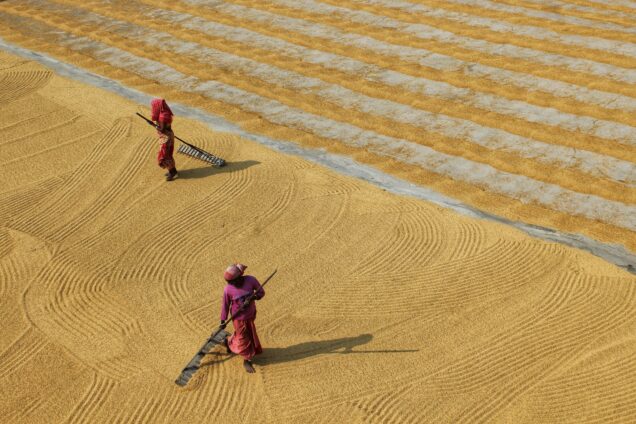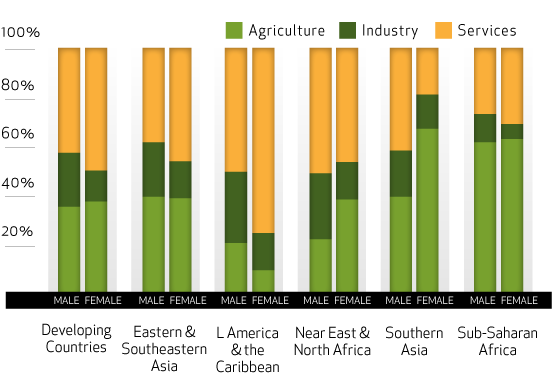The Gendered Impacts of Climate Change

By Ellie Hu
Climate change has already had an observable and adverse impact on the global environment, with rising sea levels, increased incidence of droughts, storms and wildfires, and declining water supplies and agricultural production. These impacts have fallen heavily on groups that face greater vulnerabilities from natural disasters.
Among the groups most affected are women in developing countries, who constitute the majority of the world’s poor. In particular, women are especially vulnerable to climate impacts due to their reliance on natural resources for income and household work, for their employment in agriculture and for the links between climate change and incidences of gender-based violence.
Women’s reliance on natural resources
In many low-income countries, women disproportionately bear the burden of securing natural resources for their families. Because caregiving and domestic work is mostly allocated to women, they are primarily responsible for gathering firewood for cooking and fetching water for daily use. The difficulties with securing these resources escalate during climate shocks, which increase women’s work burden.
For example, water scarcity and depletion of forests could mean that women must walk longer distances to secure these resources. Depletion of groundwater resources in dry areas, such as sub-Saharan Africa, has resulted in women walking long distances holding heavy water pots, often injuring their backs, to collect water from contaminated rivers.
Additionally, as food, water or energy sources become scarce, women may be blamed for not being able to secure sufficient resources for their families. This is likely to increase conflicts within families and expose women to violence. For example, ethnographic data from Nepal suggests that limited household water access is directly correlated with higher incidence of intimate partner violence against women.
Women’s employment in agriculture
Women’s central role in domestic work and social restrictions on their mobility in public spaces often limit their access to job opportunities that are far from home. While men generally migrate to off-farm, usually higher-paid, employment in urban areas, women are confined to informal and lower-paid jobs, often in agriculture, especially in the less developed countries. In some regions, including South Asia and North Africa, women constitute the majority of the agricultural workforce, as shown in Figure 1 below. According to the UN’s Food and Agriculture Organization, there has been a “feminization of agriculture” over the last few decades, as the proportion of women employed in this sector has risen globally, most significantly in North and East Africa and Southeast Asia.
Figure 1: Share of Male and Female Employment in Agriculture, 2015

The agricultural sector is highly vulnerable to climate change. Increased occurrences of storms, floods and heatwaves due to climate change translate to crop failures, job losses and food insecurity for agricultural workers who rely on steady weather conditions to produce food. Women farmers may face additional challenges due to their unequal access to land, labor and capital, which could limit their ability to adapt to the stresses of climate change.
The rise in gender-based violence
The climate crisis has also been associated with increased sexual and gender-based violence, as it impairs existing social structures and exposes women to increased vulnerabilities. Growing evidence has shown that social, political and economic tensions generally escalate after a climate disaster, leading to an increase in gender-based violence. In the post-disaster assessment following Cyclone Nargis in Myanmar, survey respondents noted increased alcohol consumption by men and a 30 percent rise in domestic violence rates. Reports from the United Nations Population Fund show that intimate partner violence rose after the drought in East Africa, tropical storms in Latin America and similar weather events in the Arab States region. Research by the United Nations Development Program shows the climate crisis is likely to escalate social, economic and political conflicts, which may exacerbate gender-based violence.
Additionally, women and girls report a higher level of sexual assault or violence when living in camps or emergency shelters after a climate disaster, where there is limited privacy. Based on a survey collected in Bangladesh, 93 percent of the respondents reported the disaster shelters as not “women-friendly”.
Anecdotal evidence has shown how climate change could lead to a rise in the rate of child marriage in developing regions, where poor families rely on dowries as a source of income to reduce financial burdens. For example, during extreme droughts, young girls in Ethiopia and South Sudan have been sold into marriage in exchange for cattle.
There is also evidence of an increased risk of human trafficking following natural disasters. A study from the UN International Organization for Migration discovered that the sudden onset of climate disasters is likely to cause displacement, which provides traffickers with opportunities to exploit vulnerable people. Recent research from International Institute for Environment and Development and Anti-Slavery International found that young women from Northern Ghana who migrated to major cities like Accra after local droughts faced increased risk of trafficking, sexual exploitation and debt bondage.
As climate change adds economic pressure on families and leads to the loss of households and livelihoods, the overall social instability increases the risk of child marriage, gender-based violence and human trafficking.
Policy recommendations for reducing the gendered impacts of climate change
While climate change can have an unbalanced impact on women, it offers opportunities to rewrite the rules of society during times of great change. The key question is how to incorporate gender issues into policy frameworks, reconsider women’s roles and capacities and involve women as agents of change.
The first step might be to collect more inclusive quantitative and qualitative data to accurately reflect the needs of underserved women communities to inform innovative policies. It is critical to ensure sampling methods don’t have inherent gender biases and disaggregate data to reflect divergent experiences of women by age, income, disability status and other factors. Specific policies such as unconditional business grants or capital injection can also be considered to increase women’s access to economic resources in the long run. Locally, village-level governance should also be reformed to be more gender-inclusive to further promote equal electoral participation and distribution of work. Additionally, improving transport infrastructure and reducing transportation costs would help enhance women’s mobility.
The UN Women Watch has offered systematic approaches to respond to climate change and address women’s needs: mitigation and adaptation, technology transfer and financing. Mitigation and adaptation involve a process of minimizing greenhouse gas emissions from human activities and building resilience in key sectors, such as agriculture. These efforts should effectively address the gendered effect of climate change in crucial areas like water, food security, health, human rights and agriculture.
Additionally, more innovative technologies and financing activities can be applied to support sustainable practices at the household and community level. The United Nations Framework Convention on Climate Change confirmed that women’s active participation in funding organizations, allocation of resources process and gender-sensitive investment could lead to improved outcomes of climate-related programs. Technological developments should also consider women’s specific needs and roles and make sure products are user-friendly, affordable and effective.
Currently, women are underrepresented in the decision-making process for environmental governance even though, in many cases, they are leading the initiatives for environmental conservation. For example, in the Sundarbans in India, as the rising sea levels have eroded the embankments and placed hundreds of local villagers at risk, local women have banded together to plant mangrove trees as protective barriers. In Nicaragua, women started the Gloria Quintanilla peasant cooperative to replace the chemical-intensive methods of growing coffee with agroecological practices to produce traditional crops like bananas, plantains and maize. The initiative helped ensure self-sufficiency and also used the profits to fund community education and technical training for women.
In all, women’s perspectives and efforts to address climate change need to be recognized and incorporated into national and local policies to ensure equal rights and equal participation.
*
Never miss an update: Sign up to receive the Economics in Context Initiative’s newsletter.
